Making Basic Chinese Chicken and Pork Stock
Normal people have cookouts on Labor Day weekend. They gather around the grill with their buddies for a day of beer, beach volleyball, and burgers.
At least, that is what most folks did when I was growing up.
I have long since given up on pretending to be normal; everyone who knows me terms me what was politely called “different” in my hometown of Charleston West Virginia. In the UK, they have a more melodious term for it which I prefer: eccentric.
So, what do eccentrics like me do on Labor Day?
We kick back for a relaxing day of making Cantonese Roast Pork Noodle Soup.
Why bother to make a noodle shop classic on a holiday?
Because it may well be a noodle shop classic, but as there are no classic noodle shops here in Athens, Ohio, eccentrics like myself take up the challenge to make it at home.
And really, it isn’t such a bother as all that. It just requires that you make a couple of elements of the recipe in advance: roast pork, and proper Chinese stock, in order to make the soup taste right.
I have already taught you how to make roast pork, also known as char siu, so this post is going to cover the basics of making Chinese style chicken and pork stock in your very own kitchen.
Really traditional Chinese chicken and pork stock is essential to making excellent Chinese noodle soups. With hot and sour soup, which has so many other flavoring elements, a plain chicken broth or stock can be used, but noodle soups rely less on seasonings and more on traditional meat stocks for flavor. I have found over the years that taking the time to just go ahead and make the proper Chinese stock makes more sense in the long run, than it does to start with a substandard packaged broth.
Besides, it is easy to make lots of stock at once and then freeze the excess for use in soups and other recipes later. So long as you have freezer space, this is a good plan–and frankly, after tasting good homemade stock, lots of folks will -make- freezer space for it.
For those of you who have read my post on making classic French style chicken stock entitled, “Making Stock: The Good, The Bad, and The Ugly,” you have a good working knowledge of how to make basic stocks. If you haven’t read it, or have never made stocks before, please follow the link and read it; I explain very carefully the science behind making stocks, and all of the whytos and wherefores about working with bones and animal parts with which one may not be familiar.
The Chinese method is very similar to the French method, but it is much more usual for there to be a mixture of meats and bones in the basic stocks of the Chinese kitchen. Usually the mixture includes parts of chicken and of pig; chicken and pork are the basic meats of most of China, so they are what is used on a daily basis in the kitchen. Chinese Muslims will exchange the pork for lamb or beef, while strictly vegetarian Buddhists will eschew meat stocks all together and will make vegetable, mushroom and seaweed based broths.
The amounts of pork bones and meat to chicken bones and meat are roughly 1:2; the types of pork and chicken bones and bits you use are up to you. I like to use pork neck bones and country ribs with thick slabs of meat on them. I also learned the trick of using a slice of ham with a bit of bone in it from reading Florence Lin’s excellent books on Chinese cookery and I wholeheartedly agree with her; the slight smoky flavor the ham imparts to the stock is perfect. The chicken I use tends to be whole chickens (giblets removed–organ meats make stocks somewhat bitter) and chicken feet. I like the flavor and body that chicken feet give to the stock, though backs and necks are good, too.
Whatever you use, be sure and rinse the meats and bones thoroughly with cold water and trim away excess fat, as well as any obvious bloody spots.
Blanching the Bones and Meat
One other major difference in the Chinese method of stock making and the French method is that the bones and meat are always blanched before they are made into stock. This means that you put all of your bones and meat into the pot, cover them with cold water and bring them to a slow simmer, then allow them to boil for about ten minutes. At this time, a great amount of blood, fat, and other impurities (connective tissues, proteins and the like) will be pulled out of the bones and flesh and will result in a large amount of scum rising to the surface of the pot. Skim the scum as you do in French stock making, and then, after fifteen minutes, turn the heat off of the pot, remove it from the stove and pull out the bones and meat. Rinse all of them under cold water, scrubbing them with your hands well to remove the flecks and bits of ick that have stuck to them.
I know for a fact you won’t want to do this, and since the French chefs don’t do it, I can sense folks thinking, “Why should I?”
There is a very good reason for it, and it is this: simply skimming the scum from the top of the stock as it simmers never gets all the floating particulate matter out of the stock. The French get past this by either refrigerating the stock over night and skimming off the rest of the particulate matter, which floats to the top and adheres to the fat layer. Since the French remove most of the fat from the stock and tend not to use it for anything else (this is generally true, but not in every case), this works well. However, Chinese cooks and chefs leave some of the fat intact, and when they skim the rest, they tend to save it for use later. (There is another French method for clarifying stock that is an utter pain in the rear end to do: it involves using ground veal, egg whites and egg shells to make a floating “raft” which draws the impurities to the top of the stock, where it all floats together and becomes trapped in a big glom on the top. Then, you remove the raft, and voila–clear stock. What a pain!)
So, rather than make rafts or waste fat, the Chinese get rid of the nasties before they make their stock, and the result is a much clearer product with what turns out to be less work in the end. It just doesn’t seem that way when you are doing it the first time or two.
After you have rinsed all of your bones, bits and meat, drain out the rest of the water. You will notice a big layer of scummy, icky mess all over the inside of your stock pot. Scrub it clean! You don’t want that in your stock!
Then, after you have rinsed the bones, bits and meat, -and- scrubbed your pot clean, put everything back, along with your vegetables: I use scallions and fresh ginger, which is traditional, along with a few carrots, which is not traditional, but which gives a nice subtle sweetness and color to the stock. Put the pot on the fire, bring it to a simmer, and let it cook at a bare shimmering simmer for about six hours. Eight is better. Nine is best.
Skim the tiny bits of scum that float to the top of the pot and get rid of them. You won’t have to do this very much–most of that stuff was blanched away in the first step.
After six to nine hours of simmering, it is time to pull the bones, bits and meat out, and then pour the stock through several layers of cheesecloth. I always save the meat bits for later uses–even if it is just as a treat for the kitties–and then I wash the stockpot again, then put the stock back into it and cool it off before refrigerating it overnight.
Skimming the Fat
After the stock has been chilled overnight, you will find that the fat has congealed on the top in a velvety pale yellow layer. You will also find that the stock has most likely congealed into a mass of pale translucent gelatin. That is good! That means you made a great stock filled with body and vitality that any Chinese chef would be proud of. The pale color is fine; the color of Chinese soup stocks comes from the soy sauce that is added later; for basic stocks, only a small amount of soy is added and only after it has cooked all the way. The solidified cold stock occurs because of the natural gelatin that is present in bones and connective tissue, and has been extracted by the cooking process. Gelatin gives stock a special body and feel that is delicious on the tongue, and gives a velvety feel to soups and sauces made with it.
Skim most of the fat off the top of the stock; when I am dealing with a solid gelatin layer beneath the fat, I find that it is easiest to simply “slice” the fat off with a wok spatula.Take almost all of the fat off and don’t worry if you get some bits of the gelatin with it. Save the fat and stock chunks you skim off; for one thing, you may want to add a tiny bit more fat to your stock after you have reheated and seasoned it to give it further richness. For another thing, you can stick it in the freezer, and if you are using commercial chicken broth for a Chinese recipe and want to give it a bit more flavor and oomph, you can add a bit of the stock and fat to it.
Finishing the Stock
Once most of the fat is off the surface of the stock, reheat it on medium heat, stirring it as the gelatin and fat melt into a pale liquid. At this point, season it with some thin or light soy sauce and some Shao Hsing wine, and bring it to a simmer What you will find is that you have a lovely, fragrant amber stock filled with the essence of both chicken and pork, which is barely salty and has the depth of Shao Hsing Wine. Golden droplets of fat bead up on the top in ephemeral bubbles of iridescence, and this stock is now ready to be used as a basis for soups, braised dishes, sauces or any other use in the Chinese kitchen.
Making Soup from the Stock
Making a basic, neutral-flavored soup stock from the plain chicken and pork stock is simple: After bringing it to a second simmer and seasoning it, allow it to reduce by about 1/4. This will strengthen the flavors of the stock a bit and give it a better, more luxurious mouthfeel. At this point, season it to taste with light soy sauce, salt and a tiny bit of sugar. This is now a basic soup stock that is ready to be simmered with whatever flavorings are needed for a particular soup, or to be used as is.
Chinese Style Pork and Chicken Stock
Ingredients:
4 pounds of pork bones and meat, including a slice of ham with a bit of ham bone
8 pounds of chicken bones and meat, including either necks and backs or feet
water as needed
6-8 scallions, trimmed and rinsed, white and light green parts only
3 medium carrots, peeled and cut into thirds
3″ chunk fresh ginger, peeled and cut into three parts
about 1/4 cup light or thin soy sauce
1/4 cup Shao Hsing wine
Method:
Trim excess fat and any obvious bloody bits from the bones and meat. Rinse all in cold water, and put into pot large enough to hold them all. Add cold water to cover. Set on stove, turn heat to high and bring to a simmer, then a boil. Boil for ten to fifteen minutes, allowing scum and impurities to gather as a dirty foam on the top of the water.
Remove from heat, and with tongs, pull out bones and meat and put them into a strainer. Pour out all water and discard. Rinse the meat and bones thoroughly with cold water, rubbing as necessary to remove the collected scum from their surface. Scrub out pot. Return meat and bones to pot along with scallions, carrots and ginger. Add cold water to cover and put on stove. Turn heat to medium and bring to a simmer. Turn down until a very bare simmer is maintained, with the water shimmering and tiny bubbles collecting around the solids and the sides of the pot, then bursting slowly.
Allow to cook like this for at least six hours. Nine is better. While it is cooking, check to make certain it is not boiling, and skim any foamy scum that collects at the top–there will not be much, but there will be some. You only need to do this a couple or three times.Other than that, you can ignore the stock as it cooks.
When it is finished cooking, remove the bones and meat with tongs or skimmer. Remove meat and save it if you want. Discard bones (Compost heaps are good places to bury the bones, but not the meat.) Put about four to six layers or cheesecloth into a colander and put this contraption over another pot (you may need to use several pots to collect all of the stock from the stockpot) and strain the stock in it. Scrub out the pot, and return the stock to it. Cool it down as quickly as you can–I like to set the pot into the sink along with a bunch of ice and water and stir the pot until it comes down to forty degrees. Then, I cover the pot and stick it in the fridge overnight.
In the morning or sometime the next day or evening, skim most of the fat off the top of the pot. Add the soy sauce and wine, and put the pot back on the stove, turn the heat to medium low and stirring, bring to a simmer. If you want, add a bit more fat to the stock–the surface of the liquid stock should be dotted with swirls of golden bubbles or beads of liquid fat. Too much makes it greasy, but too little makes it flavorless.
If you want, follow the instructions above to make the stock into a basic soup stock, or package and freeze it as is for use in soups, sauces and braised dishes later.
20 Comments
RSS feed for comments on this post.
Sorry, the comment form is closed at this time.
Powered by WordPress. Graphics by Zak Kramer.
Design update by Daniel Trout.
Entries and comments feeds.

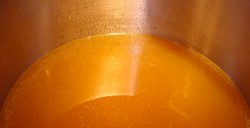
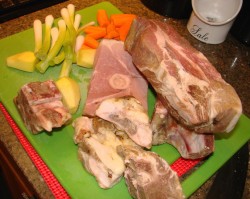
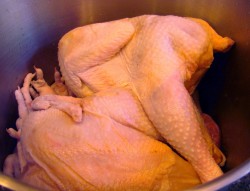
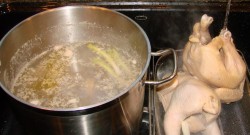

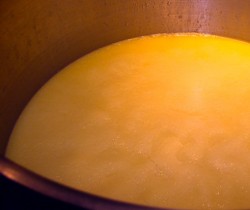
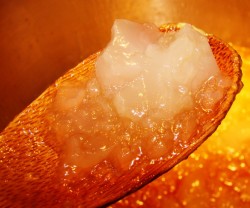
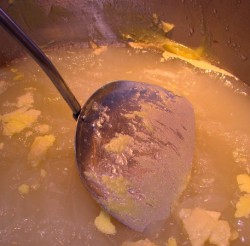



The part about cleaning the meat after blanching in fascinating. I can see how that would work, but would have expected there to be a loss of flavor. Apparently not enough to matter. Will definately give this a try some weekend when it gets colder. Nothing beats homemade stock.
Comment by Adam Ziegler — September 3, 2007 #
Adam–in my experience, you don’t lose any flavor by blanching the bones. I know that there are some European recipes that call for blanching the bones as well–including French, but it is always done in Chinese cookery.
Even when larger cuts of meat are braised in Chinese cooking, they are blanched in plain water first, rinsed and then they are put in a clean pot with seasonings to cook. It does result in purer flavors and clearer stocks and sauces.
Comment by Barbara — September 4, 2007 #
I guess I’m eccentric to, since I spent part of Labor Day making pesto to freeze. 🙂
Comment by Alexis — September 4, 2007 #
Yep, Alexis–welcome to the Club of Culinary Eccentrics.
Comment by Barbara — September 4, 2007 #
[…] Barbara Fisher has written a nice page on making French style stock (chicken), and on Chinese style stock making (mixed). I have to admit that I discovered these pages hours into my stock, but they make for good reference on method (and reason), as would any good cook book. […]
Pingback by Pork stock « House-of-Yes — September 18, 2007 #
[…] In informative posts, learn how to sweat onions and mushrooms at 101 Things Every Cook Should Cook, find out how to cook an artichoke at A Year at Oak Cottage, read top cooking tips from Ferran Adria over at Chez Pim, David Lebovitz provides 8 Tips for Using Olive Oil, learn how to season a wok at A Daily Obsession, learn how to pressure can and how to make Chinese chicken and pork stock from Tigers and Strawberries, and find out how to arrange a buffet table at Apartment Therapy. […]
Pingback by Columbus Foodie » Blog Archive » September 2007 Roundup — November 6, 2007 #
Wow, I have treid checken foot stock only and boiled up scum then skimmed and finally clarifed using an egg white only raft which was quite easy and very efficient. My stock was totally clear. Also, since I boiled it took less than six hours. Gelatoin gelled up to be a very solid collagen stock.
Next time I will try i the Chinese way. But even so I see the sti=ock in photos looks cloudy. I may try the raft to clarify anyways.
Comment by Karnajo — March 29, 2008 #
I made this a few weeks ago to freeze. We just had the first soup out of it yesterday and it was great. I have learned so much from your site and appreciate it.
Comment by Lizah — December 19, 2008 #
I’ve made your pork and chicken stock several times since finding your blog.
You’ve opened my eyes to the joys of this basic and made my wonton and roast pork soups the envy o my friends and family.
Now when I see pork neckbones on sale( personal best: .49 @ lb) I get the urge to make stock. Even in the heat of the summer. I accomplish this by blanching the bones as you suggested (in the relative coolness of 5:00 AM)then continuing with my slow cooker for the remaining cooking hours. Keeps my home much cooler.
I’m about to make a batch this morn and finally have smoked ham on hand to add in. Should make a great addition to my last summer camping menu.
Thanks again and keep on blogging :).
Comment by Vettie — August 20, 2009 #
Thanks for this recipe. I loved all the information you gave on how to make a good broth (both Chinese and French method), I’ve learnt a lot.
Thank you very much.
Comment by Patricio — September 24, 2009 #
Hi, what should be the appropriate size of the stock pot to make this?
Comment by Melissa — November 7, 2010 #
[…] night, which means soup night. We had one last package of Chinese BBQ pork and one last quart of Asian stock, which will go in the slow cooker when Peeps gets home from work. Then we can add some fresh […]
Pingback by Monday Musings: 01-10-11 « Dark Side of the Fridge — January 10, 2011 #
Hi there,
My girlfriend and I adore chinese chicken and sweetcorn soup from our local restaurant and we tend to order it about once a week after a heavy night.
I’ve recently been interested in making it for ourselves and indeed I’ve found a few simple-looking recipes but they all depend on a base stock. Clearly the real work is in making a quality stock.
From looking through this site, it definitely appear to be quite a long and involved process but I can imagine that there is no other way to really get the best results.
Thanks for the recipes and the howto, I will give it a bash this week 🙂
Atb,
F. G.
Comment by Fat Gary — July 25, 2011 #
So do you discard the water used to initially blanch the meat and bones or not? This is not made explicit in the first section of the instructions. You say, “drain out the rest of the water.” This is ambiguous.
Comment by Matthew Hartog — December 3, 2011 #
I didn’t think it was ambiguous at all, Matthew.
If you read the recipe, you will come across this passage which answers your question quite tidily:
“Remove from heat, and with tongs, pull out bones and meat and put them into a strainer. Pour out all water and discard. Rinse the meat and bones thoroughly with cold water, rubbing as necessary to remove the collected scum from their surface. Scrub out pot.”
Note that not only do you discard the water, you rinse the meat and bones well and wash the pot before continuing to make the stock.
I’m sorry that the sentence in the blog post itself wasn’t quite clear enough, but the recipe itself is perfectly explicit.
Comment by Barbara — December 4, 2011 #
[…] or broth. This was a delicate, subtle broth with a light burst of flavour. Ming made hers from this site though wasn’t happy with the fact that hers was somewhat cloudy. I thought it was beautiful, […]
Pingback by Ming’s Homemade Wonton Soup to Welcome 2012 and the Importance of Cooking with Friends — January 9, 2012 #
[…] We did take advantage of the cooler weather last weekend to make a batch of Asian chicken stock – and we had one extra quart that wouldn’t fit into the canner. Â You know what a quart […]
Pingback by Monday Musings: 04.30.2012 Edition « Dark Side of the Fridge — April 30, 2012 #
I’ve been looking up videos and various recipe sites for the last couple days looking for information on how to make good broth for Ramen and your blog just blew the rest of them out of water! Thank you for putting the time aside to write this as thoroughly as you did (pictures and all!). Can’t wait to see what my hubby will say if I put chicken feet on shopping list! =) Thanks again!
Comment by Rebecca Mustard — June 23, 2012 #
Thank you, Rebecca. I’m glad you like the blog post and found it useful. I worked hard when I wrote this blog regularly to make each post as thorough and useful as possible, in large part because I tended to be teaching unusual techniques to readers who were often very unfamiliar with them.
Good luck, and if you ever have questions, all comments on my blog posts come in my email so I will get them and be able to answer them.
Comment by Barbara — June 23, 2012 #
I have to be on a clear diet for a couple of days and am going to make this broth to keep me from feeling deprived. The only drawback is that I will be consumming it while in the middle of a 100+ degree heatwave. lol Thanks for all your attention to detail. I am certain I will enjoy making it and ultimately preparing a full fledged soup with it next week.
Comment by T — August 14, 2012 #